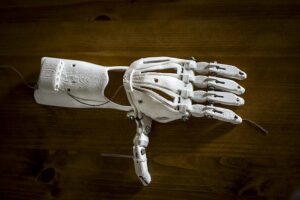
Democratizing design is about making the tools and processes of creation accessible to everyone, regardless of background, location, or income. It means breaking down the walls that traditionally separate professional designers and manufacturers from regular folks who have ideas but lack the means to bring them to life. By putting powerful, easy-to-use tools into the hands of individuals, we enable a wave of creativity and innovation that can come from anywhere and anyone.
3D printing plays a massive role in this movement. This technology allows you to create physical objects from digital designs. Think of it as building something layer by layer until you have a fully formed object. Unlike traditional manufacturing methods, which often require expensive molds or specialized machinery, 3D printing lets you bring your ideas to life with just a printer and some materials.
In the past, it is building something new usually meant going through big factories and costly manufacturing processes. Regular folks couldn’t afford the machinery or the technical know-how. This kept many brilliant ideas locked up. Now, that’s changing. The barriers that once made it difficult for everyday people to create and innovate are crumbling, thanks to the advancements in 3D printing technology. This shift levels the playing field and opens up new personal and professional growth possibilities.
Check it out here— Adventurer 5M Pro
The Evolution of 3D Printing Technology
3D printing, also known as additive manufacturing, started making waves back in the 1980s. In those early days, it was mostly used in industrial settings for prototyping and manufacturing parts. The technology was expensive and not easy for the average person to access.
Over the years, significant advancements have transformed 3D printing. Improvements in software, hardware, and materials have made it more user-friendly and cost-effective. For instance, early printers could only use specific types of plastic. Today, you can find printers that work with a wide range of materials, including metals, ceramics, and even bio-materials.
One of the major turning points was the expiration of key patents in the late 2000s. This opened up the market, allowing new players to enter and innovate. As a result, we saw an explosion of affordable 3D printers, some small enough to fit on a desktop. These machines have become more reliable and easier to use, making 3D printing more accessible to hobbyists, educators, and small businesses.
The shift from industrial to consumer accessibility has been a game-changer. In education, 3D printers are now common in classrooms, giving students hands-on experience with advanced technology. In medicine, they’re used to create custom prosthetics and even organs for research. Small businesses and startups are using 3D printing to prototype new products without the need for massive capital investment.
The impact on different industries has been profound. In manufacturing, it has led to the concept of ‘just-in-time’ production, reducing waste and lowering costs. In fashion, designers are using it to create intricate, custom pieces that were previously impossible. Even in the culinary world, chefs are experimenting with 3D-printed food.
The evolution of 3D printing technology reflects a broader trend toward the democratization of tools and processes. It’s not just about making existing methods cheaper and more accessible; it’s about unlocking entirely new ways of creating and innovating. The advances we’ve seen so far are just the beginning.

Benefits of Accessible 3D Printing
Accessible 3D printing unlocks a realm of possibilities, empowering individuals to turn their creative ideas into tangible realities without needing deep pockets or specialized knowledge. One of the biggest advantages is the way it fuels creativity and innovation on a personal level. With a 3D printer, the process of taking an idea from concept to physical object becomes faster and more efficient. Whether it’s a customized phone case, a unique piece of jewelry, or a complex mechanical part, the power to create lies at your fingertips.
Small businesses and startups particularly benefit from the cost-effectiveness of 3D printing. Traditional manufacturing often involves high initial costs, and large production runs to justify the expense. In contrast, 3D printing allows for small-scale production without the hefty price tag. This flexibility can be crucial for testing prototypes or offering customized products tailored to individual customer needs.
Customization is another significant benefit. Unlike mass production methods, 3D printing makes it easy to tailor products to specific requirements. This has significant implications for industries such as healthcare, where personalized medical devices or prosthetics can drastically improve patient outcomes. Even in fields like fashion or sports, custom-fitted products can offer better performance and comfort.
Sustainability is yet another strong point. Because 3D printing builds objects layer by layer, it tends to generate less waste compared to traditional machining, which often involves cutting away material. This reduction in waste is good for the environment and can lower material costs, making it a greener choice. Additionally, the materials used in 3D printing can often be recycled, adding another layer of sustainability.
Accessible 3D printing also promotes local production and reduces the dependency on far-flung supply chains. Enabling production closer to the point of consumption shortens lead times and reduces transportation costs. This capability not only speeds up the delivery process but also reduces the carbon footprint associated with shipping goods long distances. In an increasingly globalized world, the ability to produce locally can offer significant advantages.

Challenges and Barriers to Making 3D Printing Accessible
While 3D printing holds great promise, several challenges still need to be addressed to make it accessible to everyone. One of the most significant obstacles is the cost. Despite prices dropping over the years, high-quality 3D printers and materials can still be quite expensive. For many people, especially hobbyists and small businesses with limited budgets, the initial investment can be a significant barrier.
The technical knowledge required to operate a 3D printer is another hurdle. 3D printing isn’t as simple as hitting the print button. It involves a learning curve that includes understanding various software for designing and slicing models, as well as troubleshooting issues that might arise during the printing process. Without proper guidance and resources, this can be daunting for beginners.
Intellectual property and copyright issues also pose challenges. With the ease of replicating designs, there’s a risk of infringing on the rights of original creators. Navigating the legal landscape can be complex, especially for those who are new to 3D printing. Setting up clear guidelines and understanding the legal implications is crucial for avoiding potential pitfalls.
Quality and consistency are also areas of concern. While 3D printing technology has improved, ensuring that every print meets high standards can be tricky. Variations in material quality, printer calibration, and environmental factors can all affect the final product. Developing best practices and quality control measures is essential for achieving reliable results.
Educational initiatives and community support play a vital role in overcoming these barriers. Workshops, online tutorials, and maker spaces are fantastic resources for learning and sharing knowledge. By participating in these communities, individuals can gain the skills and confidence needed to fully harness the potential of 3D printing. Encouragement and support from experienced users can make a world of difference.
Innovative solutions are emerging to tackle these challenges. Subscription services that offer access to 3D printers and materials at a lower cost are becoming more popular. These services often include training and support, making it easier for newcomers to get started. Open-source designs and software also contribute by reducing costs and providing high-quality resources for everyone.
The journey to making 3D printing accessible to all is ongoing. Addressing these challenges requires a collaborative effort from manufacturers, educators, policymakers, and the 3D printing community. By working together, we can break down the barriers and make the creative power of 3D printing available to everyone.
Key Players in the Accessible 3D Printing Movement
Several companies and organizations have been instrumental in driving the accessible 3D printing movement. One of the early pioneers, MakerBot, brought 3D printing into the mainstream with its affordable and user-friendly printers. Founded in 2009, MakerBot aimed to make 3D printing technology available to the general public. Their printers, along with comprehensive educational resources, have helped countless individuals take their first steps into 3D printing.
Prusa Research, founded by Josef Prusa, is another significant player. Known for its reliable and open-source 3D printers, Prusa Research has a strong community-driven approach. By sharing their designs and encouraging user modifications, they've created a collaborative environment that fosters innovation and learning. Their printers are popular among both beginners and experienced users due to their robust performance and ease of use.
Ultimaker also deserves a mention. Recognized for their high-quality and versatile 3D printers, Ultimaker focuses on the professional and educational sectors. They offer a range of products designed to meet various needs, from desktop models for classrooms to more advanced systems for industrial applications. Their ecosystem of software, materials, and support services makes 3D printing more accessible and effective.
Community-driven platforms play a vital role as well. Thingiverse, an online repository for user-created digital designs, allows individuals to share and download models for free. This open-source approach provides a wealth of resources for 3D printing enthusiasts at no additional cost. The collaborative nature of platforms like Thingiverse promotes knowledge sharing and innovation, helping to spread the benefits of 3D printing.
Non-profit organizations are also contributing to the cause. E-NABLE, for example, focuses on providing affordable prosthetics to those in need. By leveraging 3D printing technology and a global network of volunteers, E-NABLE offers custom prosthetic hands and arms to individuals who might not otherwise have access to these life-changing devices. Their work demonstrates how 3D printing can be used for social good.
Profiles of key influencers highlight the human aspect of the movement. Individuals like Naomi' SexyCyborg' Wu have gained recognition for their efforts to make 3D printing more accessible and inclusive. Through social media and online tutorials, they share their knowledge and experiences, inspiring others to explore the possibilities of 3D printing. These influencers play a crucial role in fostering a diverse and supportive community.
Success Stories: Real-World Applications of Accessible 3D Printing
Accessible 3D printing has led to numerous inspiring success stories, showcasing its vast potential across different fields. One compelling example comes from the medical industry, where individuals and small businesses have made significant strides. Prosthetics are often costly and time-consuming to produce, but organizations like Open Bionics use 3D printing to create affordable, custom prosthetic limbs. This technology allows for rapid prototyping and adjustments, providing patients with tailored solutions that improve their quality of life.
In education, 3D printing has become a powerful tool for enhancing learning experiences. Teachers are using 3D printers in classrooms to bring abstract concepts to life, making subjects like math, science, and engineering more tangible and engaging. For instance, students at various schools have designed and printed their own models of cells, atoms, and historical artifacts. This hands-on approach not only increases understanding but also sparks a greater interest in STEM fields.
Small businesses and entrepreneurs have also harnessed the power of 3D printing to innovate and compete. Local jewelry designers, for example, use 3D printing to create intricate pieces that would be difficult or impossible with traditional methods. This capability allows them to offer unique, customizable products to their customers, giving them a competitive edge in the market. Additionally, startups can quickly prototype and iterate on their product designs, reducing time-to-market and development costs.
Hobbyists and DIY enthusiasts are another group benefiting from accessible 3D printing. Take Naomi 'SexyCyborg' Wu, who gained fame through her custom 3D-printed wearables and tech gadgets. She shares her designs online, encouraging others to explore and experiment. Stories like hers highlight how 3D printing can be a platform for personal expression and community building.
Community-driven projects have also emerged, using 3D printing to address local and global challenges. A noteworthy example is the construction of affordable housing using 3D-printed components. Projects in countries like Mexico and the United States have demonstrated the feasibility of using 3D printing to build sturdy, cost-effective homes quickly. This approach not only addresses housing shortages but also provides a scalable solution for disaster relief and low-income communities.
These success stories illustrate the transformative power of accessible 3D printing. The technology enables people from all walks of life to innovate, create, and solve problems in ways that were previously out of reach. The real-world applications are vast, spanning from personal projects to large-scale community initiatives, each contributing to the broader movement of democratizing design.
How to Get Started with 3D Printing: A Beginner's Guide
Choosing a 3D printer can feel overwhelming with so many options on the market. Start by defining your needs and budget. For beginners, entry-level models like the Creality Ender 3 or Prusa Mini are great choices. These printers are affordable, easy to assemble, and offer excellent print quality.
Gathering essential tools and materials is your next step. Besides the 3D printer itself, you'll need filaments, which are the materials used to print objects. PLA is a good filament to start with; it's versatile and easy to work with. Don't forget essential tools like a scraper for removing prints, tweezers, and a good set of pliers.
Learning resources are abundant and can be incredibly helpful. Online tutorials, forums, and communities can guide you through the basics and beyond. YouTube channels like Maker's Muse and 3D Printing Nerd offer detailed reviews and how-to guides that are perfect for beginners. Websites like Thingiverse provide ready-to-print designs and are a great starting point for your first projects.
Start small with your first 3D printing projects. Simple designs will help you get the hang of your printer without too much frustration. Thingiverse has an endless supply of beginner-friendly projects to help you practice and build your confidence.
Over time, you'll want to dive into 3D design to create your custom models. Software like Tinkercad is beginner-friendly and offers features that allow you to design your objects without needing advanced technical skills. Tons of tutorials are available to help you get the most out of these design tools.
Don't be afraid to experiment. 3D printing is as much about learning from failures as it is about celebrating successes. Make adjustments, try different settings, and stay patient. Every mistake helps you understand the process better.
Joining a community can make a big difference. Local maker spaces, online forums, and social media groups can provide support, answer questions, and share tips. The 3D printing community is known for being welcoming and helpful to newcomers, so don't hesitate to reach out.
Future Trends and Innovations in 3D Printing
Emerging technologies are poised to take 3D printing to new heights. One exciting development is the integration of artificial intelligence (AI) into the 3D printing process. AI can optimize print settings, predict and correct errors in real time, and even suggest design improvements. This makes the printing process more efficient and accessible, particularly for beginners who might struggle with the nuances of 3D printing.
Bioprinting is another groundbreaking innovation. By printing with bio-compatible materials, researchers are developing ways to create human tissues and organs. While still in the experimental stage, this technology holds the promise of revolutionizing fields such as medicine and pharmaceuticals by providing custom-made tissues for research and potential future transplants.
Multi-material 3D printing is set to expand the range of applications even further. Current printers often use a single type of material, limiting the functionality of printed objects. With multi-material printing, it's possible to combine different properties and functions in a single print. This could lead to the production of more complex and useful items, such as wearable tech or advanced prosthetics.
Sustainability trends are also making waves. The use of recycled materials and developments in eco-friendly filaments can reduce the environmental impact of 3D printing. Companies and researchers are increasingly focusing on biodegradable and sustainable materials, contributing to a more responsible approach to manufacturing.
Distributed manufacturing is becoming more feasible with advancements in 3D printing technology. Instead of relying on centralized factories, production can be decentralized, with products printed locally or even at home. This can reduce supply chain dependencies, enhance customization, and lower transportation costs, making manufacturing more flexible and responsive to consumer needs.
As 3D printing evolves, regulatory frameworks will need to catch up. Governments and international bodies are beginning to consider how to manage the implications of widespread 3D printing. Topics such as intellectual property rights, safety standards, and ethical considerations will shape the future landscape of the industry.
Finally, education and training will continue to evolve as critical components. As technology advances, educational institutions are increasingly incorporating 3D printing into their curriculums. Training programs and workshops will adapt to cover new technologies and applications, ensuring that the workforce is prepared to leverage these advancements effectively.
Adventurer 5M- Get $20 Off with Code SA5M! Now Only $379.00
FREE 2 Rolls of Filament with Any Flashforge 3D Printer!
The Path Forward for Democratizing Design
Making 3D printing accessible is not just about technology; it's about unlocking human potential. By breaking down the barriers that once restricted creative expression to a privileged few, we can tap into a wellspring of innovation from diverse sources. This democratization of design empowers individuals to take control of the creation process, regardless of their background or resources.
Community engagement and advocacy are crucial in this journey. Supporting local maker spaces, participating in online forums, and sharing knowledge can help build a robust, inclusive ecosystem. The more people who have access to 3D printing technology, the more vibrant and innovative the community will become.
Policy and regulation will play a big role in shaping the future landscape. Advocating for policies that support accessibility, affordability, and responsible use of 3D printing technology can create a more equitable playing field. This includes addressing issues such as intellectual property, safety standards, and environmental impact.
It's an exciting time for 3D printing and design. The technology is evolving rapidly, and new possibilities are emerging every day. Staying informed about the latest developments, participating in the community, and continuing to explore and experiment are the keys to making the most of this incredible technology.
As we look to the future, the focus should be on inclusivity. By ensuring that everyone has the opportunity to participate in the 3D printing revolution, we can unlock a wealth of untapped potential. The path forward is one of collaboration, innovation, and shared progress, paving the way for a more creative and connected world.
Happy Printing,
Bullwinkle
I hope you found this blog post helpful. If you did, please share it with your friends and leave a comment below. And if you want to learn more about writing, check out my other blog posts on 3D printing, affiliate marketing, and writing. Thanks for reading! ?
Make them laugh, make them think, but above all, make them feel!


